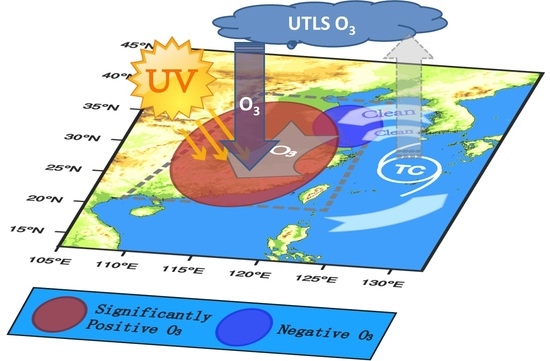3-D Changes of Tropospheric O3 in Central and Eastern China Induced by Tropical Cyclones over the Northwest Pacific: Recent-Year Characterization with Multi-Source Observations
Abstract
1. Introduction
2. Data and Methods
2.1. ERA-5 Reanalysis
2.2. Remote-Sensing O3 Monitoring Data
2.3. Near-Surface O3 Observational Data
2.4. Northwest Pacific TC Datasets
2.5. Division of Northwest Pacific Regions
3. Results and Discussion
3.1. Near-Surface O3 Variations during TC Season
3.2. Vertical O3 Variations in the Troposphere
3.3. Meteorological Anomalies for Horizontal Transport and Photochemical O3 Production
3.4. Vertical Transport of O3 Driven by TC Circulations
4. Conclusions
Author Contributions
Funding
Data Availability Statement
Conflicts of Interest
References
- Yue, X.; Unger, N. Ozone vegetation damage effects on gross primary productivity in the United States. Atmos. Chem. Phys. 2014, 14, 9137–9153. [Google Scholar] [CrossRef]
- Ramanathan, V.; Callis, L.; Cess, R.; Hansen, J.; Isaksen, I.; Kuhn, W.; Lacis, A.; Luther, F.; Mahlman, J.; Reck, R.; et al. Climate-chemical interactions and effects of changing atmospheric trace gases. Rev. Geophys. 1987, 25, 1441–1482. [Google Scholar] [CrossRef]
- De Forster, P.M.F.; Shine, K.P. Radiative forcing and temperature trends from stratospheric ozone changes. J. Geophys. Res. 1997, 102, 10841–10855. [Google Scholar] [CrossRef]
- Pan, L.L.; Homeyer, C.R.; Honomochi, S.; Ridley, B.A.; Weisman, M.; Barth, M.C.; Hair, J.W.; Fenn, M.A.; Butler, C.; Diskin, G.S.; et al. Thunderstorms enhance tropospheric ozone by wrapping and shedding stratospheric air. Geophys. Res. Lett. 2014, 41, 7785–7790. [Google Scholar] [CrossRef]
- Hidy, G.M. Ozone process insights from field experiments—Part I: Overview. Atmos. Environ. 2000, 34, 2001–2022. [Google Scholar] [CrossRef]
- Jenkin, M.E.; Clemitshaw, K.C. Ozone and other secondary photochemical pollutants: Chemical processes governing their formation in the planetary boundary layer. Atmos. Environ. 2000, 34, 2499–2527. [Google Scholar] [CrossRef]
- Schnell, J.L.; Prather, M.J. Co-occurrence of extremes in surface ozone, particulate matter, and temperature over eastern North America. Proc. Natl. Acad. Sci. USA 2017, 114, 2854–2859. [Google Scholar] [CrossRef] [PubMed]
- Wang, T.; Xue, L.; Brimblecombe, P.; Lam, Y.F.; Li, L.; Zhang, L. Ozone pollution in China: A review of concentrations, meteorological influences, chemical precursors, and effects. Sci. Total Environ. 2017, 575, 1582–1596. [Google Scholar] [CrossRef] [PubMed]
- Ni, Z.Z.; Luo, K.; Gao, Y.; Jiang, F.; Huang, C.; Fan, J.R.; Fu, J.S.; Chen, C.H. Spatial–temporal variations and process analysis of O3 pollution in Hangzhou during the G20 summit. Atmos. Chem. Phys. 2020, 20, 5963–5976. [Google Scholar] [CrossRef]
- Emanuel, K. Tropical cyclones. Annu. Rev. Earth Planet. Sci. 2003, 31, 75–104. [Google Scholar] [CrossRef]
- Jiang, Y.C.; Zhao, T.L.; Liu, J.; Xu, X.D.; Tan, C.H.; Cheng, X.H.; Bi, X.Y.; Gan, J.B.; You, J.F.; Zhao, S.Z. Why does surface ozone peak before a typhoon landing in southeast China? Atmos. Chem. Phys. 2015, 15, 13331–13338. [Google Scholar] [CrossRef]
- Wang, H.; Lyu, X.; Guo, H.; Wang, Y.; Zou, S.; Ling, Z.; Wang, X.; Jiang, F.; Zeren, Y.; Pan, W.; et al. Ozone pollution around a coastal region of South China Sea: Interaction between marine and continental air. Atmos. Chem. Phys. 2018, 18, 4277–4295. [Google Scholar] [CrossRef]
- Chen, Z.; Liu, J.; Cheng, X.; Yang, M.; Wang, H. Positive and negative influences of typhoons on tropospheric ozone over southern China. Atmos. Chem. Phys. 2021, 21, 16911–16923. [Google Scholar] [CrossRef]
- Chow, E.; Li, R.; Zhou, W. Influence of Tropical Cyclones on Hong Kong Air Quality. Adv. Atmos. Sci. 2018, 35, 1177–1188. [Google Scholar] [CrossRef]
- Huang, J.-P.; Fung, J.C.H.; Lau, A.K.H.; Qin, Y. Numerical simulation and process analysis of typhoon-related ozone episodes in Hong Kong. J. Geophys. Res. 2005, 110, D05301. [Google Scholar] [CrossRef]
- Hung, C.-H.; Lo, K.-C. Relationship between ambient ozone concentration changes in southwestern Taiwan and invasion tracks of tropical typhoons. Adv. Meteorol. 2015, 402976. [Google Scholar] [CrossRef]
- Romps, D.M.; Kuang, Z.M. Overshooting convection in tropical cyclones. Geophys. Res. Lett. 2009, 36, L09804. [Google Scholar] [CrossRef]
- Zhan, R.; Wang, Y. Contribution of tropical cyclones to stratosphere-troposphere exchange over the northwest Pacific: Estimation based on AIRS satellite retrievals and ERA-Interim data. J. Geophys. Res. 2012, 117, D12112. [Google Scholar] [CrossRef]
- Preston, A.; Fuelberg, H.; Berth, M. Simulation of chemical transport by Typhoon Mireille (1991). J. Geophys. Res. 2019, 124, 11614–11639. [Google Scholar]
- Roux, F.; Clark, H.; Wang, K. The influence of typhoons on atmospheric composition deduced from IAGOS measurements over Taipei. Atmos. Chem. Phys. 2020, 20, 3945–3963. [Google Scholar] [CrossRef]
- Bellevue, J.; Baray, J.L.; Baldy, S.; Ancellet, G.; Diab, R.D.; Ravetta, F. Simulations of stratospheric to tropospheric transport during the tropical cyclone Marlene event. Atmos. Environ. 2017, 41, 6510–6526. [Google Scholar] [CrossRef]
- Das, S. A new perspective on MST radar observation of stratospheric intrusions into troposphere associated with tropical cyclone. Geophys. Res. Lett. 2009, 36, L15821. [Google Scholar] [CrossRef]
- Das, S.; Sijikumar, S.; Uma, K. Further investigation on stratospheric air intrusion into the troposphere during the episode of tropical cyclone: Numerical simulation and MST radar observations. Atmos. Res. 2011, 101, 928–937. [Google Scholar] [CrossRef]
- Jenkins, G.J.; Robjhon, M.L.; Reyes, A.; Valentine, A.; Neves, L. Elevated middle and upper troposphere ozone observed downstream of Atlantic tropical cyclones. Atmos. Environ. 2015, 118, 78–86. [Google Scholar] [CrossRef]
- Xu, W.; Rutledge, S.A.; Zhang, W. Relationships between total lightning, deep convection, and tropical cyclone intensity change. J. Geophys. Res. 2017, 122, 7047–7063. [Google Scholar] [CrossRef]
- Tu, J.; Chou, C.; Chu, P. The abrupt shift of typhoon activity in the vicinity of Taiwan and its association with western North Pacific–east Asian climate change. J. Clim. 2009, 22, 3617–3628. [Google Scholar] [CrossRef]
- Lam, Y.F.; Cheung, H.M.; Ying, C.C. Impact of tropical cyclone track change on regional air quality. Sci. Total Environ. 2018, 610–611, 1347–1355. [Google Scholar] [CrossRef]
- Lee, Y.C.; Calori, G.; Hills, P.; Carmichael, G.R. Ozone episodes in urban Hong Kong 1994–1999. Atmos. Environ. 2002, 36, 1957–1968. [Google Scholar] [CrossRef]
- Huang, J.-P.; Fung, J.C.H.; Lau, A.K.H. Integrated processes analysis and systematic meteorological classification of ozone episodes in Hong Kong. J. Geophys. Res. 2006, 111, D20309. [Google Scholar] [CrossRef]
- Yang, J.X.; Lau, A.K.H.; Fung, J.C.H.; Zhou, W.; Wenig, M. An air pollution episode and its formation mechanism during the tropical cyclone Nuris’s landfall in a coastal city of south China. Atmos. Environ. 2012, 54, 746–753. [Google Scholar] [CrossRef]
- Wei, X.; Lam, K.-S.; Cao, C.; Li, H.; He, J. Dynamics of the Typhoon Haitang related high ozone episode over Hong Kong. Adv. Meteorol. 2016, 2016, 6089154. [Google Scholar] [CrossRef]
- Feng, Y.; Wang, A.; Wu, D.; Xu, X. The influence of tropical cyclone Melor on PM10 concentrations during an aerosol episode over the Pearl River Delta region of China: Numerical modeling versus observational analysis. Atmos. Environ. 2007, 41, 4349–4365. [Google Scholar] [CrossRef]
- Dee, D.P.; Uppala, S.M.; Simmons, A.J.; Berrisford, P.; Poli, P.; Kobayashi, S.; Andrae, U.; Balmasede, M.A.; Balsamo, G.; Bauer, P.; et al. The ERA-Interim Reanalysis: Configuration and Performance of the Data Assimilation System. Q. J. Royal Meteorol. Soc. 2011, 137, 553–597. [Google Scholar] [CrossRef]
- Hersbach, H.; Dee, D.P. ERA-5 reanalysis is in production. ECMWF Newsl. 2016, 147, 7. [Google Scholar]
- Liu, X.; Bhartia, P.K.; Chance, K.; Spurr, R.J.D.; Kurosu, T.P. Ozone profile retrievals from the Ozone Monitoring Instrument. Atmos. Chem. Phys. 2010, 10, 2521–2537. [Google Scholar] [CrossRef]
- Shen, L.; Jacob, D.J.; Liu, X.; Huang, G.-Y.; Li, K.; Liao, H.; Wang, T. An evaluation of the ability of the Ozone Monitoring Instrument (OMI) to observe boundary layer ozone pollution across China: Application to 2005–2017 ozone trends. Atmos. Chem. Phys. 2019, 19, 6551–6560. [Google Scholar] [CrossRef]
- Ying, M.; Zhang, W.; Yu, H.; Lu, X.; Feng, J.; Fan, Y.; Zhu, Y.; Chen, D. An overview of the China Meteorological Administration tropical cyclone database. J. Atmos. Oceanic Technol. 2014, 31, 287–301. [Google Scholar] [CrossRef]
- Lu, X.Q.; Yu, H.; Ying, M.; Zhao, B.K.; Zhang, S.; Lin, L.M.; Bai, L.N.; Wan, R.J. Western North Pacific tropical cyclone database created by the China Meteorological Administration. Adv. Atmos. Sci. 2021, 38, 690–699. [Google Scholar] [CrossRef]
- Shu, L.; Xie, M.; Wang, T.; Gao, D.; Chen, P.; Han, Y.; Li, S.; Zhuang, B.; Li, M. Integrated studies of a regional ozone pollution synthetically affected by subtropical high and typhoon system in the Yangtze River Delta region, China. Atmos. Chem. Phys. 2016, 16, 15801–15819. [Google Scholar] [CrossRef]
- Varotsos, C.A.; Efstathiou, M.N.; Cracknell, A.P. On the temporal evolution of the tropical stratospheric ozone. J. Atmos. Sol.-Terr. Phys. 2017, 157–158, 1–5. [Google Scholar] [CrossRef]



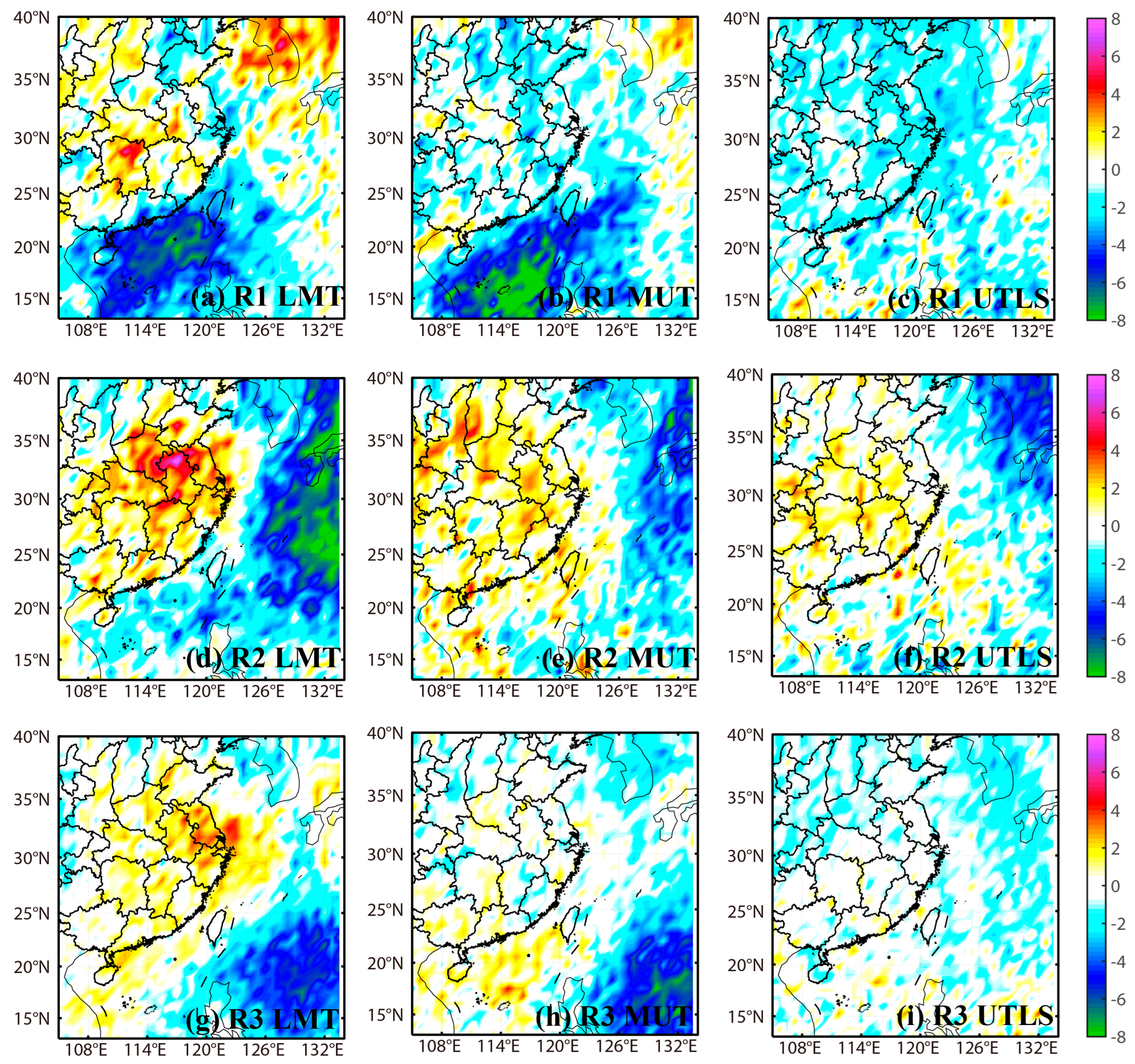

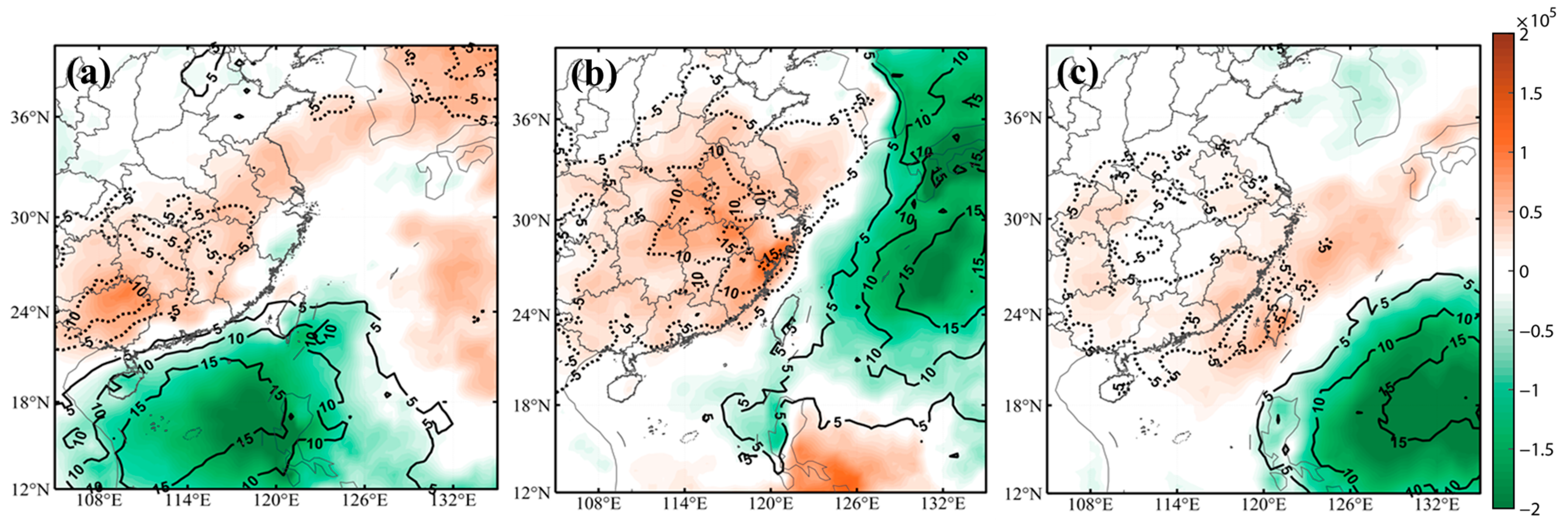
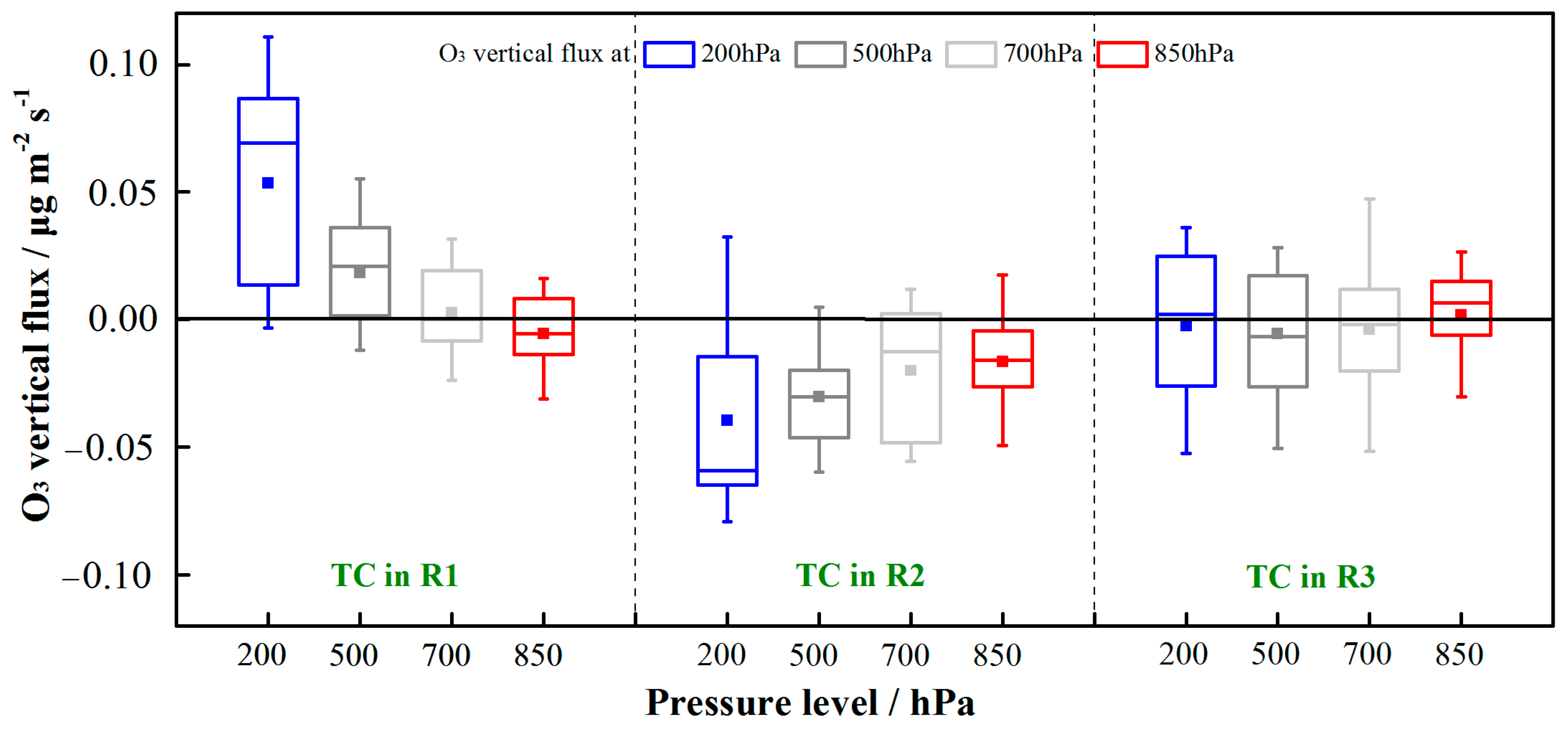
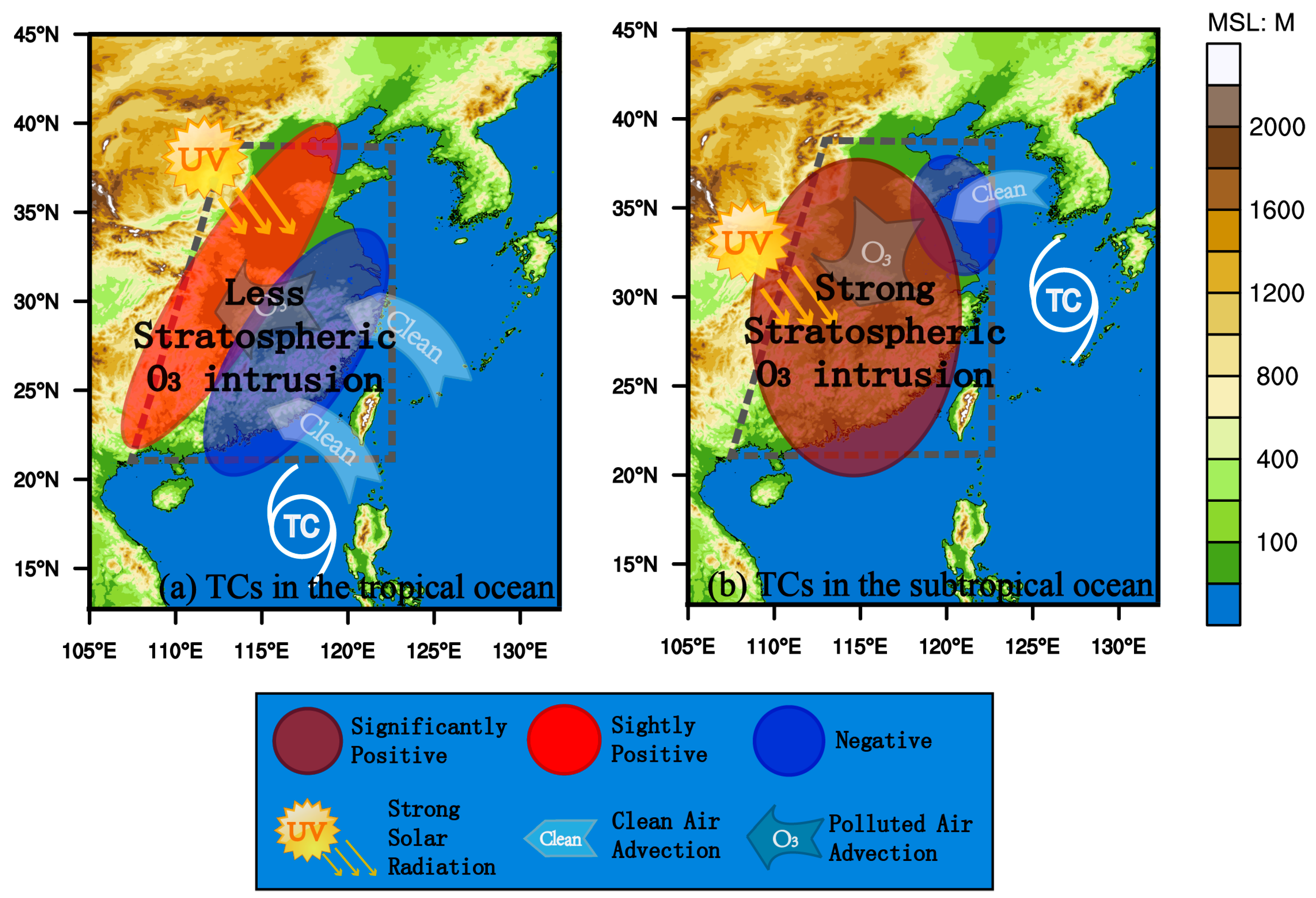
Disclaimer/Publisher’s Note: The statements, opinions and data contained in all publications are solely those of the individual author(s) and contributor(s) and not of MDPI and/or the editor(s). MDPI and/or the editor(s) disclaim responsibility for any injury to people or property resulting from any ideas, methods, instructions or products referred to in the content. |
© 2024 by the authors. Licensee MDPI, Basel, Switzerland. This article is an open access article distributed under the terms and conditions of the Creative Commons Attribution (CC BY) license (https://creativecommons.org/licenses/by/4.0/).
Share and Cite
Jiang, Y.; Zhao, T.; Meng, K.; Cheng, X.; Lv, Q. 3-D Changes of Tropospheric O3 in Central and Eastern China Induced by Tropical Cyclones over the Northwest Pacific: Recent-Year Characterization with Multi-Source Observations. Remote Sens. 2024, 16, 1178. https://doi.org/10.3390/rs16071178
Jiang Y, Zhao T, Meng K, Cheng X, Lv Q. 3-D Changes of Tropospheric O3 in Central and Eastern China Induced by Tropical Cyclones over the Northwest Pacific: Recent-Year Characterization with Multi-Source Observations. Remote Sensing. 2024; 16(7):1178. https://doi.org/10.3390/rs16071178
Chicago/Turabian StyleJiang, Yongcheng, Tianliang Zhao, Kai Meng, Xugeng Cheng, and Qiaoyi Lv. 2024. "3-D Changes of Tropospheric O3 in Central and Eastern China Induced by Tropical Cyclones over the Northwest Pacific: Recent-Year Characterization with Multi-Source Observations" Remote Sensing 16, no. 7: 1178. https://doi.org/10.3390/rs16071178
APA StyleJiang, Y., Zhao, T., Meng, K., Cheng, X., & Lv, Q. (2024). 3-D Changes of Tropospheric O3 in Central and Eastern China Induced by Tropical Cyclones over the Northwest Pacific: Recent-Year Characterization with Multi-Source Observations. Remote Sensing, 16(7), 1178. https://doi.org/10.3390/rs16071178







